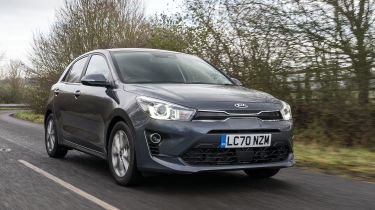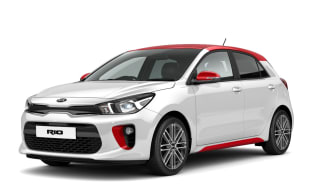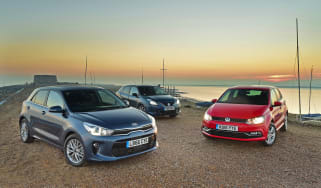Kia Rio (2017-2023) review
The Kia Rio offers good value and practicality - a safe pair of hands in a talented supermini class

The Kia Rio has come on in leaps and bounds since the no-frills original was launched. Unfortunately, the current fourth generation model isn’t a huge step on from the Mk3. It has an evolutionary design inside and out, merely average ride and refinement, and some hard, cheap-feeling interior plastics that all hurt its cause in the hugely competitive supermini class.
That said, the current car is the best version yet and is light years ahead of the Kia Rio Mk1, which was sold as a budget saloon or estate from 2000 to 2005. It just struggles to stand out in today’s market.
About the Kia Rio
To help it stay competitive, Kia mildly updated its Rio towards the end of 2020 with subtle revisions to the styling, infotainment and engine lineup.
These changes haven’t altered the Korean supermini too much, it continues to be reasonable value, offer a high-tech touchscreen infotainment system (from mid-range models and up at least) and promise decent space for passengers.
For now, the 1.0 T-GDi turbo petrol engine with the six-speed manual gearbox is our range highlight, offering strong performance and efficiency. However, the mild-hybrid 1.0 T-GDi 48V petrol engine and “clutch-by-wire” transmission (which were both added in the 2020 updates) could well prove to be the best combination when we sample it on UK roads. The Rio also comes with Kia’s seven-year warranty. It’s just a shame that the firm played it safe with the Rio’s styling, meaning the car fails to stand out visually in this hard-fought sector.
More reviews
While the original Rio stood out for all the wrong reasons, the Rio Mk2 (2005-2011) really established the supermini in a tough market. The Mk3 (2011-2017) picked up where its predecessor left off, albeit in a more stylish fashion, but it still delivered strong fuel economy and plenty of standard equipment.
The Rio Mk4 arrived in 2017, with a design that was an evolution of the Mk3 and more of the tech and quality that supermini buyers have come to expect from these types of car. The exterior featured a more prominent 'tiger nose' grille (which has been made narrower as part of the 2020 revisions), while the interior has improved switchgear and all bar the most basic model come with a touchscreen infotainment system as standard.
The Rio range comprises straightforward 1, 2 and 3 specifications, while the occasional limited edition crops up from time to time. At launch, a First Edition was offered, but GT-Line S has since superseded it as the range-topper.
All cars come with at least air-conditioning, electric heated door mirrors, Bluetooth, auto lights and LED daytime running lights. Moving up to 2 spec cars brings 15-inch alloy wheels, cruise control, rear parking sensors, a reversing camera and an 8.0-inch touchscreen infotainment system.
Go for 3 trim and you get 16-inch alloy wheels, fake leather interior and auto wipers. Range-topping GT-Line S adds 17-inch alloy wheels, various sportier-looking trims, LED headlights, black cloth and fake leather upholstery, front parking sensors and blind-spot monitoring. For reference, First Edition featured 17-inch alloys, keyless entry and LED rear lights. Prices range from £14,000 to around £20,000.
Three engines are offered in the Rio and all are petrol-powered. There is a 1.2-litre four-cylinder and two 1.0-litre turbocharged three-cylinder engines – the latter being called “T-GDi” in Kia-speak. It is only the most powerful three-pot that uses Kia’s 48-volt mild-hybrid system.
You can't get every engine in every trim, with the most powerful 118hp 1.0 T-GDi only coming in 3/GT-Line S trim, and the 99hp version only offered in 2 trim. The 1.2-litre (formerly a 1.25) is only available in trims 1 and 2. An automatic transmission is an option for the two 1.0-litre turbo engines but all Rios are front-wheel-drive.
Diesel isn't as popular as it once was in the supermini sector, and while Kia has previously offered some of the most economical cars on sale – in the form of its CRDi diesel models – the South Korean manufacturer no longer makes a diesel Rio for the UK market. Which is a shame, as the lower-powered diesel was claimed to be capable of more than 80mpg.
There are many supermini rivals to the Kia Rio, and a lot of these have been updated or replaced since the Rio arrived in 2017. Chief among them are the UK's best-selling cars, such as the Ford Fiesta and Volkswagen Polo, while the SEAT Ibiza, Citroen C3, Nissan Micra and Toyota Yaris have come on in leaps and bounds over their predecessors.
Elsewhere, Hyundai (Kia’s sister brand) offers the i20 which is closely related to the Rio. There is also the Mazda 2, which offers sharp looks and a sporty drive, while the Vauxhall Corsa is a great supermini that can sometimes be had at a heavily discounted rate. Finally, Skoda’s Fabia is well worth considering, too.
Which Is Best
Cheapest
- Name1.25 1 5dr
- Gearbox typeManual
- Price£12,820
Most Economical
- Name1.0 T GDi 48V 118 3 5dr
- Gearbox typeManual
- Price£19,870
Fastest
- Name1.0 T GDi 48V 118 3 5dr
- Gearbox typeManual
- Price£19,870


























